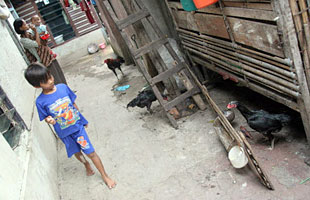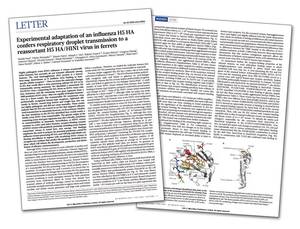The flu and the fear of the hand returns
2012/01/26 Carton Virto, Eider - Elhuyar Zientzia
Flu and fear are inseparable long ago and we are in the midst of one of those acute tandem outbreaks. On this occasion, the protagonists are two investigations carried out with the H5N1 influenza virus of birds, and the petitions in the name of biosafety before the results of these investigations.
The first signs of the outbreak emerged last September in Malta, at a conference organized by the European Flu Scientific Committee (ESWI). There, researcher Ron Foulchier of the Erasmus medical research center in Rotterdam, explained some of the results obtained with the H5N1 virus of birds: a variant of the virus created by mutation in the laboratory was able to infect it by aerosols without losing virulence. Ferrets are the best example to carry out human flu studies that is spread through the airways and the result was worrying, as it implied that the H5N1 virus of birds can produce a pandemic of flu among humans older than expected. The authors argue that the result is sufficient to doubt whether the risk level of the H5N1 virus has been underestimated. Some experts affirm that the risk is low based on the conclusions drawn from historical data, respectively: That the viruses of subgroups H1, H2 and H3 are the causes of pandemics, that the genetic mixture of human and animal viruses is necessary for the creation of pandemic agents, as well as the need for pigs to be intermediate hosteleros. However, the results obtained in the Netherlands can be indicators of the opposite.
In addition, the capacity of contagion by respiratory means has not been to the detriment of the virulence of the virus, which the researchers have also placed on the threshold of the concerns, since until now it was given in the form of tableware that, although the level of mortality of current H5N1 infections was much higher than that of the pandemic of the Spanish flu, the variation that would be transmitted in spray probably had a lower virulence. The results of the research carried out with the ferrets seem to indicate something else, so the researchers claim the need to continue with these investigations, since they can help to know how the flu viruses acquire the capacity to spread from the human being.
The results obtained in the Erasmus medical research center are not known exactly, since they have not yet been published. In the same situation is the second research mentioned at the beginning and it is estimated that it has reached similar conclusions. This is a work done in the United States, at the University of Wisconsin-Madison, which has spread much less information than the first, among other things because the principal investigator has not wanted to speak publicly since the debate broke out.
The explosion occurred on December 20, when the Government of the United States asked the authors and journals Science and Nature to publish the results of the investigations, so that the details of the methodology of the withdrawal article do not extend sufficient information so that the results can be repeated, in the name of security, are not available to potential bioterrorists. Those who should know it would have confidential knowledge of the details, but, moreover, the risks arising from the disclosure of the information were greater than the benefits.
Some measures, such as censorship, or aggression against the freedom to investigate and share results, such as Foulchier himself, refer to who decides which people and entities need to know the details and how the decision will be made. And they are not banal questions. In fact, the recommendation to limit information was issued by the U.S. Biosafety Advisory Council (CNAE), which emerged as a self-regulatory body following the antrax attacks that took place in the United States.
Likewise, those who consider the measure inadequate consider that limiting information is endangering the benefits that this type of research can report to public health. On the other side, to prevent potentially dangerous viruses from falling into the hands of criminals or from escaping the labs by accident, they prioritize measures as a benefit for public health.
The exchange of opinions and pressure received by researchers and magazines has not been low, among other things because the US government itself is the payer of the investigations. For the moment, they have not adopted a definitive decision. On 20 January, however, two research groups published a joint letter stating that they have applied a 60-day voluntary moratorium to their investigations: “We are aware that we and the rest of the scientific community must clearly explain the benefits of this important research and the measures taken to minimize potential risks. (...) We are aware that the organizations and governments of the world need time to find the best solution to the opportunities and challenges arising from this work,” they say. Two months do not seem enough to drop this knot, and to see what will be the last victims of this tandem outbreak of fear of the flu, but what is at stake is little.
Additional information:
Create special discussion sections on the web pages of Science and Nature
Published in Berria

Gai honi buruzko eduki gehiago
Elhuyarrek garatutako teknologia





